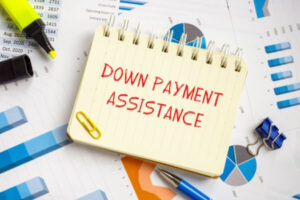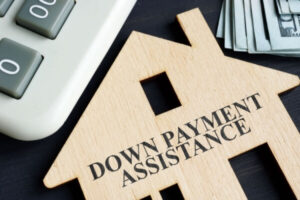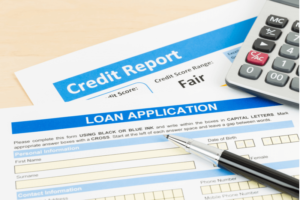Home »
Buying your first home has become an expensive rite of passage in the United States.
The National Association of Realtors says first-time buyers are spending an average of $219,000 to become homeowners.
You could get the keys to that house:
- IF you had $44,000 for a down payment
- IF you had a credit score over 700
- IF you qualified for a 4.4% interest rate
- IF you could afford a monthly payment of $1,160.
That’s a lot of IFs to handle for most first-time homebuyers, which is why federal, state and local governments offer assistance programs to put it within reach. The helps comes in the form of grants, loans and concessions on down payments that make it possible for first-time homebuyers to get in the door.
That’s IF you qualify.
What Is a First-Time Home Buyer?
A first-time home buyer, according to the FHA, is someone who has not owned a home in the last three years. There are a few exceptions to the rule.
You are still considered a first-time homebuyer if you meet one of these qualifications:
- A single parent who has only owned with a former spouse while married.
- An individual who is a displaced homemaker and has only owned with a spouse.
- An individual who has only owned a principal residence not permanently affixed to a permanent foundation in accordance with applicable regulations.
- An individual who has only owned a property that was not in compliance with state, local or model building codes and which cannot be brought into compliance for less than the cost of constructing a permanent structure.
» Learn More: Tips for First-Time Home Buyers
First-Time Home Buyer Assistance
There is help out there for consumers eager to purchase their first home. The best part is you don’t need a perfect credit score or astounding income. Here are a few ways first-time home buyer programs can save you money.
Smaller Down Payment
A lot of people have been conditioned by the longstanding 20% rule. They think they need to put down 20% of the value of the home to be granted a mortgage. While conventional mortgages like this are still in circulation, 80% of first-time homebuyers put down less than 20% to buy a home.
» Learn More: Minimum Down Payment for a First-Time Home Buyer
First-time homebuyer programs offer down payment assistance by accepting down payments as low as 3%, some as low as zero percent. The “catch” is that these offers often come attached with the requirement that you buy private mortgage insurance (PMI). This can range between 0.5%-1.5% of the value of the home.
So, if you have your eyes locked on a $219,000 home, your PMI could come out to as much as $3,285. That is $274 a month paid to mortgage insurance, which is not the same as homeowner’s insurance. PMI only covers the mortgage, not the actual home. Home insurance is an additional cost.
Lower Interest Rate
Some loan assistance programs offer interest rates lower than the 3.99% average for conventional loans in October of 2019. VA loans and USDA loans both come with interest rates that hover around 3%. The VA does not set a rate. They try to match individuals with approved lenders to decide what works best for them.
Help with Closing Cost
Closing costs are all of the fees home buyers must pay before getting their hands on the keys to the house of their dreams. These are things like taxes, insurance premiums and inspection fees. They can add up quickly. Closing cost come out to 2%-5% of the home’s value. Some lenders may offer to roll your closing cost into the loan, so you don’t have to come up with thousands of dollars upfront in order to buy the house.
Around 30% of low-income borrowers struggle to buy a home because they cannot afford the fees associated with the closing. Typically, help with closing costs can be found from local or state governments. Check your state, county or city website for any grants being offered to first-time homebuyers.
First Time Home Buyer Grants & Programs
The type of funding you qualify for will depend on where you live. A lot of these programs stem from the Department of Housing and Urban Development (HUD), but can be accessed through your state or local government.
Here are some widely available first-time home buyer grants and programs worth looking into.
FHA Home Loan Program
The Federal Housing Administration (FHA) is a federal agency; it is not a lender and they will not give you a loan directly. Instead, you get a loan from an FHA approved lender.
The FHA insures the loan, which is why lenders are willing to give loans to home seekers with less than stellar credit scores. A credit score of 580 or above can land you a loan with a 3.5% down payment. If you’re looking at a home worth $219,000, you would need a down payment of $7,665. If your credit score falls between 500-579, you would need to supply a down payment of 10% of the home’s value.
The FHA will pay the lender a settlement should the homeowner default on the loan. This means you, the homeowner, must pay monthly mortgage insurance premiums. This is how the FHA can afford to take on so much risk. They are, more or less, an insurance agency.
Mortgage insurance is almost universal for loans requiring down payments of less than 20% of a home’s value.
FHA loans were intended for low to moderate income consumers with little savings set aside for a down payment. If you have a high credit score and enough funds stashed away, you will save more in the long run if you go the route of the traditional, 20% down mortgage.
USDA Loans
USDA loans are provided by the United States Department of Agriculture and intended for the rural or suburban dweller.
You don’t have to move to the middle of Kansas to qualify for one of these loans. About 97% of the landmass of the United States counts as eligible territory. When looking at the map on the USDA’s website, you will spot small “ineligible” pockets scattered across the country. These represent metropolitan hubs. Everything else is seemingly fair game.
These loans let you finance the entire amount of the home, which means a zero percent down payment. This also means you will have to buy private mortgage insurance. Expect to pay a 1% upfront fee at the closing and a 0.35% annual fee. Annual fees are actually paid monthly.
So, if you’re looking at a house valued at $219,000, you can add $2,190 for the upfront fee when calculating the costs of closing, plus another $64 a month for the annual fee.
USDA loan interest rates are among the lowest available, lower than FHA and even conventional loan rates. USDA loan rates sit at 3.25% as of September 2019.
Visit the USDA’s website to find a list of eligible lenders and to determine whether the home of your dreams resides in an eligible area.
VA Loans
A VA loan or Veteran Affairs mortgage is backed by the VA and intended for veteran or active duty home seekers. These loans offer zero percent down payments along with some of the lowest interest rates you will find on the market.
Even without a down payment, lenders won’t force you to buy private mortgage insurance. The government will pay the lender 25% of the value of the home if you default. This is why lenders are willing to offer these kinds of deals. From where the lender stands, there is as much security in the government reimbursing them 25% of a home’s value, as there is in you putting down a 25% down payment.
VA loans do come with funding fees, which means you’ll make a one-time payment that ranges from 1.25%-3.3% of the loan.
First-Time Home Buyer Grants
Most first-time home buyer grants are location specific. They may be funded by the federal government, but to access them you’ll have to go through your state or local government. The federal government usually won’t give grant funds directly to consumers. Also, grant funds won’t cover all the costs of buying a home.
They can, however, prove indispensable in allowing you to meet closing costs or a down payment.
The National Homebuyers Fund offers down payment assistance of as much as 5% of the total mortgage. So, if your loan is $219,000, the NHF down payment assistance program may provide you with up to $10,950 in funds.
The American Dream Down Payment Initiative has a similar function. It provides low-income families with money to help close on a home. The average grant comes out to about $7,500.
How to Qualify as a First-Time Home Buyer
Each of these programs has their own specific requirements for first-time home buyers, but there are general guidelines you can keep in mind when shopping around for a first-time home buyer loan.
Income Limits
Income limits vary by program and within those programs they often vary by location. For example, a USDA loan in Wilmington, North Carolina limits your income to $86,850 or below. However, residents of Austin, Texas can earn as much as $108,550 and still qualify.
There are no income limits for FHA loans. You can be a millionaire and apply, but we wouldn’t recommend it, since conventional loans will save you more money in the long run.
Rather than focus on how little or how much you earn; FHA loans will focus on your ability to repay the loan. They put a lot more weight on your debt-to-income ratio or DTI. Generally, you will need a DTI below 43% to qualify.
Credit Qualifications
You don’t need great or even good credit to qualify for most first-time homeowner assistance programs. You can qualify for an FHA loan with a credit score as low as 500, though you’ll get better rates with a score above 579. FHA loans exists on the low end of the credit qualification spectrum, to be sure. However, you can still qualify for most first-time homeowner assistance loans with a credit score no higher than 640.
Becoming a First-Time Home Buyer Again
There are no limits to the amount of times you can qualify as a first-time home buyer. Usually, a certain amount of time must pass since you have owned a home to be considered a first-time home buyer. For an FHA Approved loan, that’s three years. Theoretically, if you bought your first home at 30 and lived to 100, you could be a first-time homebuyer over 20 times.
HUD-Approved Online Homebuyer Education Course
HomeTrek is an easy-to-use HUD-approved online homebuyer education course. Our course will help you learn budgeting, saving, how to improve your credit, understand home much home you can afford.
Down Payment Assistance Programs in California
Down Payment Assistance Programs in Pennsylvania
Down Payment Assistance Programs in New York
First-Time Home Buyer Benefits
What Is the Minimum Down Payment for First-Time Home Buyers?
First-Time Home Buyer Guide
First-Time Homebuyer Tax Credit
First-Time Homebuyer Requirements
Down Payment Assistance Programs in Texas
Credit Scores and the First-Time Homebuyer
Sources:
- Lee, D, Tracy, J. (2019, April 10) Who’s on First? Characteristics of First-Time Homebuyers. Retrieved from: https://libertystreeteconomics.newyorkfed.org/2019/04/whos-on-first-characteristics-of-first-time-homebuyers.html
- NA. ND. Median and Average Sales Prices of New Homes Sold in United States. Retrieved from: https://www.census.gov/construction/nrs/pdf/uspricemon.pdf
- NA. (2019, July 25). QUARTERLY RESIDENTIAL VACANCIES AND HOMEOWNERSHIP, SECOND QUARTER 2019. Retrieved from: https://www.census.gov/housing/hvs/files/currenthvspress.pdf
- Cororaton, S. (2017, April 6) Eighty Percent of First-time Homebuyers Put Down Less than 20 Percent Down Payment. Retrieved from: https://www.nar.realtor/blogs/economists-outlook/eighty-percent-of-first-time-homebuyers-put-down-less-than-20-percent-downpayment-based-on-december
- NA. ND. VA Home Loans. Retrieved from: https://www.benefits.va.gov/homeloans/purchaseco_eligibility.asp
- NA. ND. Single Family Housing Guaranteed Loan Program. Retrieved from: https://www.rd.usda.gov/programs-services/single-family-housing-guaranteed-loan-program
- NA. ND. FHA Loan Requirements. Retrieved from: https://www.fha.com/fha_loan_requirements










